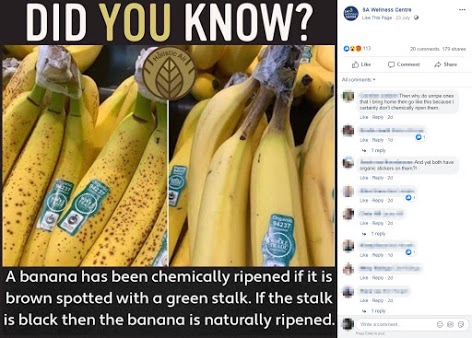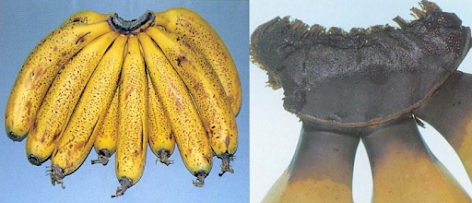The Statement
AAP FactCheck examined a Facebook post from July 23, 2019 by the Facebook verified SA Wellness Centre page which shows an image of two bunches of bananas, one with green stalks and brown spots, the other with dark stalks and no spots.

The caption beneath the image reads: “A banana has been chemically ripened if it is brown spotted with a green stalk. If the stalk is black then the banana is naturally ripened.”
SA Wellness Centre is a chiropractic business based in O’Halloran Hill, Adelaide which offers services in physiotherapy and nutrition through to wellness workshops, yoga and meditation classes.
The post had been shared more than 170 times and attracted more than 20 comments and 100 reactions.
The Analysis
The Australian Banana Growers’ Council (ABGC), the national peak industry body for Australia’s commercial banana growers, told AAP FactCheck “the chemical ripening process is essentially the same as the natural ripening process, just in a more controlled environment” and that both were triggered by the same hormone, ethylene gas.
According to Scot Nelson, a doctor in plant pathology at the University of Hawaii, bananas emit ethylene gas, a natural plant hormone that accelerates ripening by converting the starch it stores into sugar. As more ethylene builds up in a banana, the riper it will become.
All fruits do this, but bananas produce a large amount, which is why they will ripen other fruits in close vicinity.
An ABGC spokesperson told AAP FactCheck bananas were chemically ripened in Australia by placing them “into a cold room, where ethylene gas is introduced so the bananas start to transpire. When they take in oxygen and ethylene together, the bananas use that as energy to convert starches to sugars – essentially this is ripening”.
The ripening rooms have to be temperature-controlled 15 to 20 degrees, the humidity level set to around 90 to 95 per cent to induce uniform ripening, and the carbon dioxide concentration kept below one per cent to avoid delaying the ripening process, according to the Postharvest Centre at the University of California.
The Postharvest Centre is a research facility which studies the “postharvest quality, safety and marketability of fresh horticultural products” and the “technology that enhances the quality, safety and marketability” of these products.
ABGC told AAP FactCheck bananas which go through chemical ripening and those which ripen naturally do not show any visible differences and that chemically ripened bananas have no different markings to those ripened naturally.
“Bananas will at times have different marks, caused by natural events or as they continue to ripen,” the ABGC spokesperson said.
“There is no difference related to how they have been ripened. Similarly, common banana varieties will change from green to yellow as they ripen. Sometimes, you may find that a less ripe banana still has some green colouring.”
A banana with a black stalk, similar to those featured in the Facebook post, could also be experiencing a pathological disorder called “crown rot”, according to the Postharvest Centre. Crown rot was caused by a fungi which attacks the cut surface of the banana hands and spreads into the finger neck into the fruit.”
Brown spots or flecks on a banana peel could also indicate the banana is experiencing a disease called “senescent spots”. Small groups of cells appear in the outer peel, caused when over-mature fruit are sent to a ripening facility, according to Dr Scot Nelson.
The Verdict
Based on the evidence AAP FactCheck found the Facebook post which stated bananas with green stalks and brown spots were chemically ripened and those with black stalks were naturally ripened to be false.
False – The Facebook post is false.
First published July 26, 2019 17:29 AEST


















